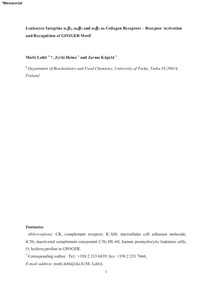Leukocyte integrins alpha(L)beta(2), alpha(M)beta(2) and alpha(X)beta(2) as collagen receptors - Receptor activation and recognition of GFOGER motif
Lahti M; Heino J; Kapyla J
https://urn.fi/URN:NBN:fi-fe2021042714627
Tiivistelmä
Integrins alpha(L)beta(2), alpha(M)beta(2) and alpha(X)beta(2) are expressed on leukocytes. Their primary ligands are counter transmembrane receptors or plasma proteins, such as intercellular cell adhesion molecule-1 (ICAM-1) or components of complement system (iC3b, iC4b), respectively. Function blocking antibodies for these integrins may also reduce cell adhesion to collagens. To make the first systematical comparison of human alpha(L)beta(2), alpha(M)beta(2) and alpha(X)beta(2) as collagen receptors, we produced the corresponding integrin alpha I domains both in wild-type and activated form and measured their binding to collagens I-VI. In the "closed" (wild-type) conformation, the alpha I-L and alpha I-M domains bound with low avidity to their primary ligands, and the interaction with collagens was also very weak. Gain-of-function mutations alpha(L) I306G, alpha(L) K287C/K294C and alpha(M) I316G are considered to mimic "open", activated alpha I domains. The binding of these activated alpha I domains to the primary ligands was clearly stronger and they also recognized collagens with moderate avidity (K-d < 400 nM). After activation, the alpha I-L domain favored collagen I (K-d approximate to 0 nM) when compared to collagen IV. The integrin alpha I-X domain acted in a very different manner since already in native, wild-type form it bound to collagen IV and iC3b (K-d approximate to 200-400 nM). Antibodies against alpha(X)beta(2) and alpha(M)beta(2) blocked promyelocytic leukemia cell adhesion to the collagenous GFOGER motif, a binding site for the beta(1) integrin containing collagen receptors. In brief, leukocyte beta(2) integrins may act as collagen receptors in a heterodimer specific manner. (C) 2013 Elsevier Ltd. All rights reserved.
Kokoelmat
- Rinnakkaistallenteet [27094]
